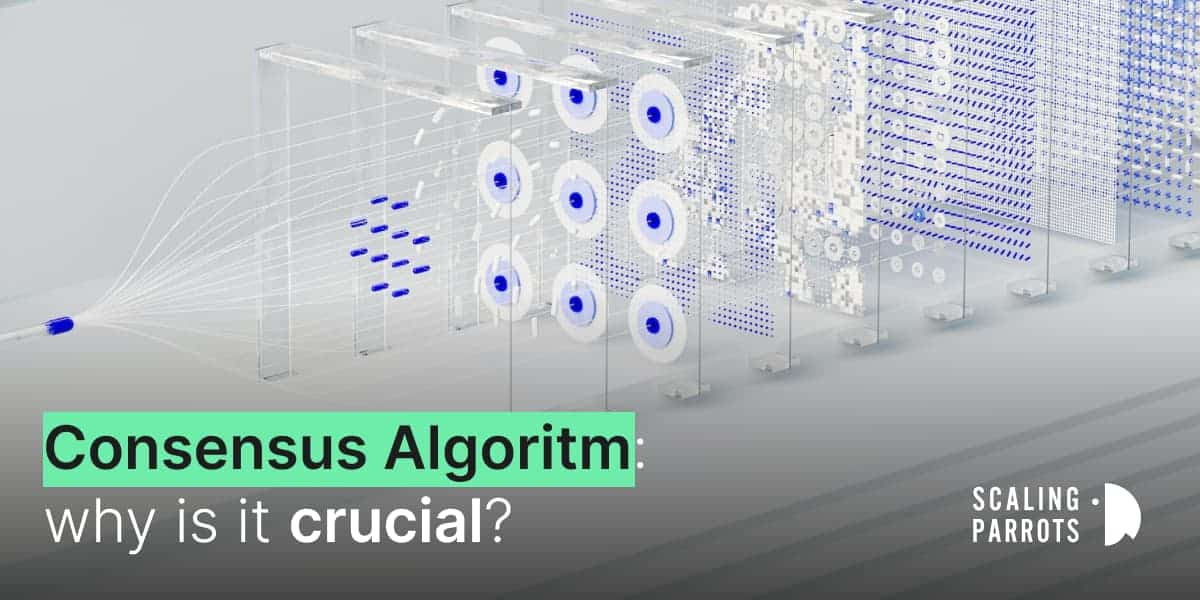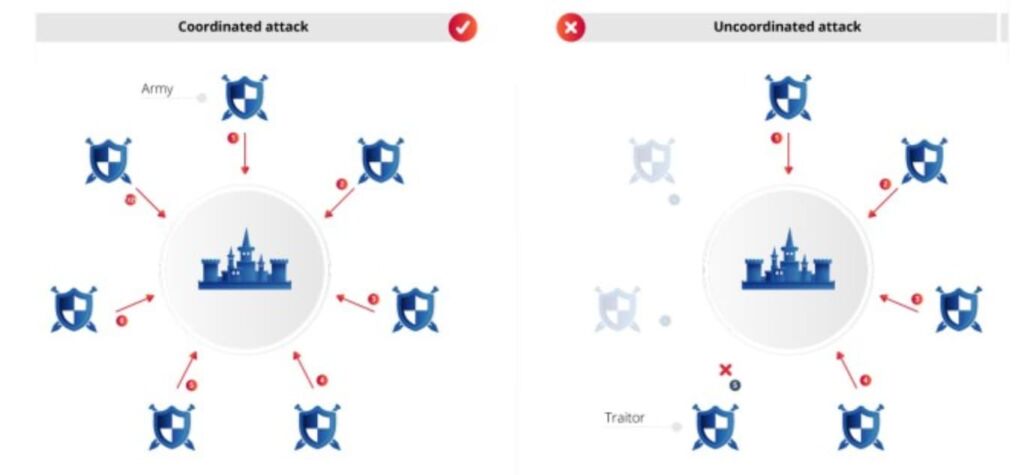
When we talk about Blockchain, we often talk about a series of blocks making up a network and a decentralized, secure, reliable process. However, the Blockchain must have a consensus algorithm to secure a Blockchain and make it reliable.
But what is the Blockchain consensus algorithm, and why does a Blockchain need it? How does it Algorithm work, and what are its properties? These questions will be addressed in the article below.
What is Blockchain consensus algorithm?
As it is known in English, Consensus means agreement, harmony, accord, or consent. Therefore, a consensus algorithm is a process for finding a deal on a single data value between distributed processes or systems. These algorithms are designed to ensure the reliability of a network involving several unreliable nodes.
It is the compliance of each actor of the Blockchain network to agree on the creation and the sequence of each block.
A Blockchain is generally independent of a single company or person because it works through the alliance of multiple actors. Each actor participates in securing the network by verifying that each transaction and interaction is possible and that no other actor or participant tries to cheat to the detriment of others.
This tedious verification process ensures that the Blockchain’s transaction history is correct and tamper-proof. All actors must agree to validate an entry in the Blockchain ledger, called a consensus algorithm.
How does Blockchain consensus algorithm work?
Because they allow a group of decentralized machines or servers to cooperate and agree on the system’s state, even in the event of failures or outages, consensus algorithms are essential in large-scale, fault-tolerant systems. The algorithm establishes a threshold, or the minimum number of member machines, to accomplish this.
Consensus algorithms address a consensus problem, assuming that a fraction of the nodes will reply and that some systems and processes will be unavailable. They also think that some transmission errors will result in lost communications. But the accessible nodes are needed to respond.
Example: For an algorithm to reach a consensus on a data value or network state, at least 51% of nodes may need to respond. This guarantees that an agreement is reached with the fewest resources possible, even if the other resources are insufficient or flawed. Additionally, the process upholds the legitimacy of the judgments made by the concurring nodes in the fault zone.
Why does Blockchain need a consensus algorithm?
One of the problems associated with Blockchain is the non-synchronization of data. Therefore, Blockchain needs Consensus Algorithm to resolve differences across nodes to ensure that at the end, there is only one copy, the Master copy (which is also the valid copy of the record), that is served by all nodes.
Another problem is that some nodes might be entirely malicious. For example, they could be operated by bad actors and generate counterfeit data with the hope that they might end up on the Blockchain and benefit themselves. So, Blockchain Consensus Algorithm is needed to deter this behavior.
The Consensus Algorithm uses majority votes to reach a consensus, which is advantageous for everyone using the Blockchain network. Because of this, using consensus methods helps produce better outcomes in distributed systems where there may be conflicting results.
These problems highlighted above are often called Byzantine general problems, making it difficult to reach a consensus. A single fault causes all nodes to be unable to agree, which makes things more challenging. Thus, Blockchain decentralization uses consensus algorithms.

Consensus algorithms are essential to maintaining the security and integrity of a cryptocurrency network. They give distributed nodes a way to agree on which copy of the Blockchain is authentic. For a digital economic system to operate appropriately, consensus on the state of Blockchain is required.
Objective of Blockchain consensus algorithm
The various objectives of the Blockchain Consensus Algorithm are highlighted below. They are but not limited to the following:
- Economic Incentive Alignment
Aligning the interests of network participants is essential when creating a trust-free platform that self-regulates.
In this case, a Blockchain consensus mechanism encourages good behavior and penalizes poor behavior. This ensures that there is also the regulation of economic incentives.
- Unified Accord
Consolidating consensus is one of the main goals of consensus processes. Users in decentralized systems can function even without developing trust in one another, unlike centralized systems where doing so is vital. Furthermore, the decentralized Blockchain network’s protocols assure the reliability and authenticity of the data used in the process and the current state of the public ledger.
- Error Tolerant
The Consensus method also guarantees the Blockchain’s consistency, reliability, and fault tolerance, another feature of it. That means the regulated system would continue to function even in the face of faults and risks.
There are currently many Blockchain consensus algorithms in use, and many more will soon hit the market. This necessitates that every Blockchain software company and aspiring entrepreneur be conversant with the characteristics of a solid consensus protocol and the potential consequences of choosing a subpar one.
- Fair and Equal
Consensus procedures allow anyone to engage in the system using the same fundamentals. This supports the Blockchain system’s open-source and decentralized characteristics.
- Prevent spending twice
Consensus mechanisms operate on the basis of specific algorithms that guarantee that only verified and legitimate transactions are recorded in the transparent public ledger. This fixes the age-old issue of spending twice or using a digital currency more than once.
Types of consensus algorithm
In Blockchain networks, there are different types of Consensus Algorithms for arriving at a consensus in a distributed manner. But three of them are discussed below. They are Proof of Work (PoW), Proof of Stake (PoS) and Federated Byzantine Agreement (FBA).
Proof of Work (PoW)
It was first created by Cynthia Dwork and Moni Naor in 1993 and relaunched by Satoshi Nakamoto (also known as the developer of Bitcoin) in 2008. It is one of the oldest and most used consensus algorithms.
Markus Jakobsson and Ari Juels used the phrase “proof of work” in a book in 1999. Although it is the most trustworthy and reliable consensus algorithm, many scaling issues exist. Ethereum, Bitcoin, and other open-source Blockchains all employ PoW.
PoW tries to generate as many projections as feasible in the shortest time by using nodes to solve challenging mathematical problems.
The PoW consensus algorithm uses the mining process to validate a transaction. The computationally difficult Proof of Work consensus mechanism adds new blocks to the Bitcoin Blockchain. The action is referred to as “mining,” and the network nodes that participate in mining are called “miners.”
Validators, also known as miners or node actors in the proof of work process, must demonstrate that the work they have completed and submitted entitles them to add new entries to the Blockchain network.
To do this, miners must crack the new block’s mathematical riddles before uploading it to the database. Before approving the copies of the ledger, the solution is then sent to additional validators for review.
Using Proof of Work (PoW) verification for every transaction helps the core network of the Blockchain prevent double-spending. In other words, if anyone tries to duplicate a transaction in the Blockchain network, it will be seen in the system and will not be accepted. Hence, no one can change the transaction once it has been verified and approved by every node participant.
The most popular proof-of-work consensus was first implemented as part of Bitcoin and is based on SHA-256. Scrypt, SHA-3, scrypt-jane, scrypt-n, and others are also included.
Proof of Stake (PoS)
A stake is the amount of money or value we bet will happen. The procedure is known as staking. A quantum mechanic initially proposed this method of reaching consensus, and Sunny King and a colleague later published a paper on it. As a result, Proof-of-Stake (PoS)-based Peercoin was created.

PoS is a more environmentally friendly alternative to PoW that uses less CPU processing power to mine. As a result, PoS is frequently regarded as the most ecologically responsible PoW alternative.
PoS and PoW have similar goals but different processes. Accordingly, in PoS, also known as Stake, the new block maker is picked deterministically based on wealth, unlike PoW, where a miner must solve mathematical riddles to create a new block.
Additionally, PoS saves time and energy. But participants must invest in Stake to become a validator (money). Additionally, since there are no benefits for miners in the system, they can keep their transaction fees.
Put simply; validators will spend in the network currencies and lock part of them as stakes rather than spending money on expensive technology to solve complicated puzzles. For example, if they locate a block that can be connected to the same network, the validators will stake a bet on it, validating the blocks in the process.
Federated Byzantine Agreement (FBA)
The Federated Byzantine Agreement (FBA) is another Blockchain consensus algorithm employed in Blockchain networks. The FBA supports open membership, allowing validators to join the network freely. It is prominent for its high throughput, scalability, and low transaction costs.
A specific group of signers must sign a transaction. In an FBA system, validators can choose which other validators they trust, and from there, they form what is known as a quorum slice.
In a system with many validators, there may be multiple quorum slices, and with numerous quorum slices, there becomes overlap with some nodes being trusted in various slices. These overlaps come together to form the overarching quorum, which is used to reach a consensus in FBA. Notable projects that employ FBA in Blockchain networks are Ripple(XRP) and Stellar(XLM).
Some of the advantages of FBA include the following:
- Low barrier to entry as membership is open as long as it can be trusted and join a quorum slice.
- Anyone can join and leave at any time with the system still functioning.
Properties of good Blockchain consensus algorithm
A good Blockchain Consensus Algorithm should not fail to have the following properties:
- Inclusive
A successful consensus algorithm ensures that each network node is active in the voting process.
- Egalitarian
Another feature of a reasonable consensus algorithm is that every vote received from the node is given equal value and weight.
- Safety
All nodes can generate accurate results according to protocol rules in a sound consensus system.
- Participatory
A consensus process in which all nodes are actively involved and contribute to updating the Blockchain database is considered a model of solid consensus.
- Liveness
Another property of a good Blockchain consensus algorithm is liveness. If every malfunctioning node involved in the consensus finally produces a value, the liveness of the algorithm is assured.
- Tolerance and Non-repudiation
A consensus algorithm provides fault tolerance if it can recover from failure often or participate in a consensus. A good consensus algorithm also provides the means to verify that the supposed sender sent the message.
- Consumption of Energy
The utilization of energy-intensive calculations was fundamental to PoW, and as the number of consensus nodes increased rapidly, so did the energy usage. Thus, energy consumption has become a crucial factor for Blockchain consensus design, as several consensus methods that emerged after Bitcoin PoW aimed to overcome this issue.
- Synchronicity
Another quality of a successful Blockchain consensus method is synchronicity. The moment consensus nodes arrive at a consensus is referred to as synchronicity. Minimal situations make it possible to ensure that messages will be received by a specific time. For example, a node’s internet connection may experience a temporary slowdown or even go offline, disconnecting it, or the physical cables connecting the computers may be rerouted, increasing the delay. Therefore, events must occur simultaneously.
Conclusion
Blockchain networks would only be able to operate correctly and achieve complete decentralization with consensus algorithms. Of course, there is no one-size-fits-all approach to confirming and authenticating the Blockchain’s legitimacy. However, it wouldn’t be incorrect to infer that each of these algorithms aims to achieve consensus in the distributed Blockchain network.
For Blockchain technology, a variety of recommended consensus algorithms have been made, and to use Blockchain effectively, we should be aware of all of them. Therefore, our top priority is finding the first and optimal algorithm for our Blockchain initiatives.
That being said, the consensus algorithm is being used by multiple Blockchain platforms to gain consensus. But, the type of consensus mechanism you should add to your business platform depends on the functionality the platform needs to provide.
See you soon,
Scaling Parrots
